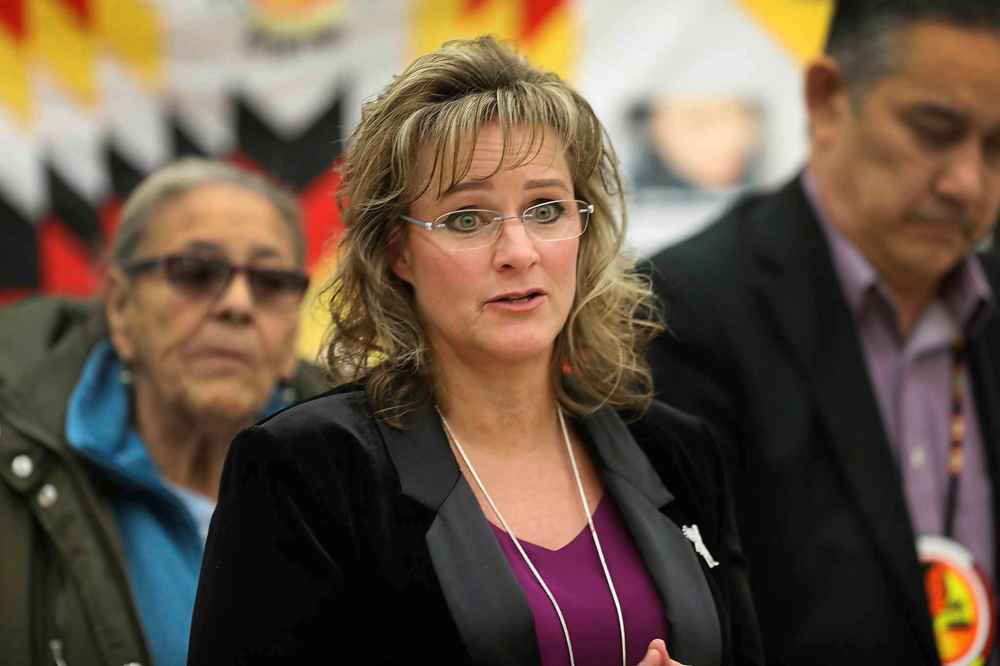‘A shameful legacy’ Scathing report on Tina Fontaine's troubled life, tragic death points to systemic failures rooted in colonialism
Read this article for free:
or
Already have an account? Log in here »
To continue reading, please subscribe:
Monthly Digital Subscription
$0 for the first 4 weeks*
- Enjoy unlimited reading on winnipegfreepress.com
- Read the E-Edition, our digital replica newspaper
- Access News Break, our award-winning app
- Play interactive puzzles
*No charge for 4 weeks then price increases to the regular rate of $19.00 plus GST every four weeks. Offer available to new and qualified returning subscribers only. Cancel any time.
Monthly Digital Subscription
$4.75/week*
- Enjoy unlimited reading on winnipegfreepress.com
- Read the E-Edition, our digital replica newspaper
- Access News Break, our award-winning app
- Play interactive puzzles
*Billed as $19 plus GST every four weeks. Cancel any time.
To continue reading, please subscribe:
Add Free Press access to your Brandon Sun subscription for only an additional
$1 for the first 4 weeks*
*Your next subscription payment will increase by $1.00 and you will be charged $16.99 plus GST for four weeks. After four weeks, your payment will increase to $23.99 plus GST every four weeks.
Read unlimited articles for free today:
or
Already have an account? Log in here »
Hey there, time traveller!
This article was published 12/03/2019 (2465 days ago), so information in it may no longer be current.
The long-awaited report into Tina Fontaine’s tragic life and death exposes gaping, still unrepaired holes in Manitoba’s social safety net.
The 115-page document, authored by Manitoba Advocate for Children and Youth Daphne Penrose calls for sweeping changes across myriad federal and provincial government departments and agencies and was delivered with a stark warning Tuesday.
“Children are going to die if we don’t make changes,” Penrose said in Sagkeeng First Nation. Tina, 15, was raised on the First Nation, 145 kilometres northeast of Winnipeg.

"This can’t be another report that gets shelved."
She said her office is aware of 17 youths who are currently in immediate danger because of drug addictions and lack of available treatment.
The advocate’s office will be conducting audits to see how the federal and provincial governments are responding to its five recommendations, and an implementation report is expected in six months.
The report begins before Tina’s birth and continues well past her August 2014 death that served as the tipping point across Canada, leading to the eventual creation of the National Inquiry into Missing and Murdered Indigenous Women.
It calls for improvements in schools, child-welfare agencies, the justice system and mental-health and addictions treatment for youths. And it offers new insight on Tina’s struggles — including details that were unknown even by those closest to her.
Advocate’s findings and recommendations
• Finding: After her father’s death by homicide, Tina’s absenteeism increased significantly. However, there were no documented responses by the school to address her chronic absenteeism or a co-ordinated plan to address her escalating behaviours. Following a suspension in April of 2014, Tina did not return to school.
Recommendation: Improve how schools deal with absenteeism — review the use of suspensions. Tina missed most of her Grade 8 year and never returned to school after she was suspended in April 2014.
• Finding: After her father’s death by homicide, Tina’s absenteeism increased significantly. However, there were no documented responses by the school to address her chronic absenteeism or a co-ordinated plan to address her escalating behaviours. Following a suspension in April of 2014, Tina did not return to school.
Recommendation: Improve how schools deal with absenteeism — review the use of suspensions. Tina missed most of her Grade 8 year and never returned to school after she was suspended in April 2014.
• Finding: The death of Tina’s father was a profoundly traumatic event that occurred at an especially vulnerable stage in her development, the transition from childhood to adolescence. Timely, easily accessible, and culturally safe bereavement services and grief counselling ought to have been made available to Tina and her family.
• Finding: Mental-health counselling supports were recommended several times for but never provided.
Recommendation: Expedite youth mental-health strategy recommendations contained in previous provincial health consultant’s report — “Tina had acute mental-health needs following her father’s death but she was never provided with a single counselling session or other cultural healing, despite ongoing assessments and recommendations that this was a critical need in her life,” the advocate’s report said.
• Finding: Tina was not invited to participate directly in the process of accessing victim services; these decisions were deferred to adults in her life.
• Finding: Following the death of Tina’s father, victim services did not provide Tina the counselling to which she was entitled. Had the process been streamlined and the quality of services consistent, Tina might have been able to access timely compensation benefits, primarily in the form of counselling.
Recommendation: Ensure quality victim support services are provided to children — this recommendation asks Manitoba Justice to bring in quality-control measures to make sure other children have timely access to the victim support services to which they are entitled. After Tina’s death provincial victim services program acknowledged to the advocate’s office that it erred by not clearly communicating to Tina and her family that they were eligible for counselling services and other benefits after the murder of Eugene Fontaine in 2011.
• Finding: Starting in Tina’s early years, child and family services did not reflect a commitment to preserving, supporting and protecting Tina’s family unit, in accordance with the Declaration of Principles within The Child and Family Services Act. Instead, Tina’s family experienced multiple fractures to its structure while receiving child and family services.
• Finding: Legal guardianship is often recognized, practised and understood differently by mainstream government systems and Indigenous communities. In Tina’s case, government service providers and some child and family service agencies did not acknowledge customary practices as legitimate. This contributed to service delivery confusion for Tina and her family.
• Finding: In her final months of life, and with multiple child and family service agencies involved, Tina did not receive the child and family service interventions and resources she required to support her through her addictions and to protect her from the adults who were exploiting her.
• Finding: Manitoba continues to lack safe and secure placement resources for children who are at risk of imminent harm or death.
Recommendation: Child and Family Services needs to develop a “safe and secure” place for children who are at risk of being sexually exploited and have nowhere else to go. “Safe and secure does not mean institutionalized,” Penrose said. “It does not mean jail.” She said “there is a desperate need” in Manitoba for these types of placements.
• Finding: Indicators of sexual exploitation were not detected early enough for Tina to allow for proactive intervention and her protection across multiple public service systems.
• Finding: Manitoba has the highest prevalence rate of missing children and youth in Canada. Tina’s frequent periods of going missing from home were another indicator for sexual exploitation.
Recommendation: Manitoba’s Families Department must implement a response protocol when youth go missing. Tina was in “imminent danger” and should have had access to secure and culturally informed treatment programs: “the full continuum of services for children,” the advocate’s investigation found. Penrose said this is “not a difficult” recommendation for the province to implement. The needs of high-risk youth are already tracked by CFS agencies and police, she said, so it would be more effective for them to work together.
“I have more compassion for Tina after finding out from the report what she was going through at the time,” her aunt Thelma Favel — the woman who raised her — told the Free Press.
Penrose made it clear blame should not be laid at Tina’s feet, or those of her mother.
“We have a shameful legacy that we have to carry, and now our responsibility is walking in reconciliation," she said in an interview.
"We have to support communities by being present and being mobilized to help our Indigenous brothers and sisters, help with children because those are our children, too, and we all have a responsibility, because what Tina struggled with is not Tina’s burden. It’s all of our burdens.”
It would be “short-sighted” to blame child-welfare agencies for Tina’s death, she said. Even though Tina was in care for short periods of time near the beginning and again near end of her life, her story is more complex — rooted in colonialism.
A clear turning point, however, was the 2011 beating death of her father. She was living with Favel, who tried repeatedly to obtain counselling to help Tina through her grief; requests for those services were made through her school and Child and Family Services but never materialized.
As a result of the advocate’s investigation, Manitoba Justice’s victim services program acknowledged it made a mistake by not clearly telling Favel the family was eligible for counselling and other benefits in the aftermath of Eugene Fontaine’s murder.
The investigation revealed many such missed opportunities where Tina could have received help before her emotional struggles fuelled her desire to reconnect with her mother in Winnipeg, where the young teen spiralled into missing school, cutting her arms, running away and being repeatedly sexually exploited by men as she tried to survive on city streets far from her home community.
var paidAccessCheck = function(){
if($(“.paidaccess”).css(“display”) == “block”){
root.__charttooldispatcher = root.__charttooldispatcher || {};
var dispatcher = root.__charttooldispatcher;
window.onload = function(){
setTimeout(dispatcher.redraw, 10000);
}
var data = {
“version”: “1.4.2”,
“id”: “AvGsaKotS4459D3zP”,
“heading”: “Missing children 2017”,
“qualifier”: “”,
“source”: “Source: Manitoba Advocate for Children and Youth”,
“tags”: [],
“chart”: {
“class”: “primary”,
“hasHours”: false,
“data”: “province,Male,FemalenMan.,3758,7865nOnt.,6052,4973nB.C.,2946,4513nQue.,4413,2612nSask.,1915,2682nAlta.,1729,2235nN.S.,250,395nN.B.,297,203nN.L.,128,99nYukon,23,29nN.W.T,5,26nP.E.I.,13,7nNunavut,0,0”,
“options”: {
“annotations”: true,
“expanded”: false,
“footer”: true,
“head”: true,
“indexed”: false,
“interpolation”: false,
“legend”: true,
“qualifier”: true,
“share_data”: true,
“social”: true,
“stacked”: true,
“tips”: true,
“type”: “bar”,
“x_axis”: true,
“y_axis”: true
},
“x_axis”: {
“display”: true,
“scale”: “linear”,
“ticks”: “auto”,
“orient”: “bottom”,
“format”: “comma”,
“nice”: false
},
“y_axis”: {
“display”: true,
“scale”: “ordinal”,
“ticks”: “auto”,
“orient”: “right”,
“format”: “comma”,
“nice”: false
},
“annotations”: {
“highlight”: [],
“range”: [],
“text”: [],
“pointer”: []
}
}
};
root.ChartTool = root.ChartTool || [];
root.ChartTool.push({id: “ct-” + data.id, data: data});
var b = document.getElementsByTagName(“body”)[0];
if (!b.classList.contains(“ct-charttool-init”)) {
b.classList.add(“ct-charttool-init”);
var c = document.createElement(“link”);
var j = document.createElement(“script”);
c.href = “https://wfpdata.s3.amazonaws.com/chart-tool/v4/chart-tool.css?token=0”; c.rel = “stylesheet”;
j.src = “https://wfpdata.s3.amazonaws.com/chart-tool/v4/chart-tool.js?token=0”; j.async = true; j.defer = true;
document.getElementsByTagName(“head”)[0].appendChild(c);
document.getElementsByTagName(“head”)[0].appendChild(j);
}
clearInterval(verifyPaidAccess);
}
}
var verifyPaidAccess = setInterval(paidAccessCheck,500);
})(this);
“At every point in contact, being able to remove her and take her to a place of safety where she felt it was home probably would have helped her,” Penrose said.
Tina’s mother, Valentina Duck, was 17 and in CFS care when she was born. Her father, Eugene Fontaine, was 28, and they had already been in a sexual relationship for five years. When Tina was two, her parents were seen “weaving down the street,” intoxicated with her in tow, and she and her younger sister were placed in a foster home before being returned to their father’s care later that year. The girls moved in with their “grandma,” Favel, in 2004.
Timeline of Tina’s final four weeks
A look at how the Winnipeg Police Service and CFS agencies responded each time the young teenager was reported missing
July 18, 2014
(missing persons report filed)
WPS: Speaks with family members on the phone
CFS: Speaks with family members on the phone and submits after-hours service request
July 21
WPS: Attempt phone contact with CFS agency and family members
July 18, 2014
(missing persons report filed)
WPS: Speaks with family members on the phone
CFS: Speaks with family members on the phone and submits after-hours service request
July 21
WPS: Attempt phone contact with CFS agency and family members
July 22
WPS: Speaks with family members, CFS agency, and other relevant people
CFS: Speaks with family member on the phone and speaks with Tina on the phone
July 23
WPS: Cancels missing person report
CFS: Attends an address in search for Tina; Tina shows up at agency office
July 27
(missing persons report filed)
July 28
WPS: Calls youth shelter, advised Tina had returned; Cancels missing person report
July 31
(missing persons report filed)
Aug. 1
CFS: Attends an address in search for Tina; attempts to connect with family members by phone; Speaks with two youth shelters regarding a bed for Tina; Tina attends a shelter but doesn’t stay
Aug. 2
CFS: Agency receives call from Tina. Shelter bed is arranged, but Tina does not attend
Aug. 6
CFS: Attempts to reach family member by phone
Aug. 7
WPS: Speaks with youth shelter staff on the phone
Aug. 8
WPS: Has in-person contact with Tina, she is permitted to leave; informed of Tina being treated by paramedics on Ellice Avenue; Cancels missing person report
CFS: Tina attends a youth shelter, leaves shortly after; CFS agency checks Tina after she’s discharged from hospital
Aug. 9
(missing persons report filed)
WPS: Issues BOLO (Be on the lookout) for Tina
Aug. 11
WPS:Speaks with CFS agency, family member, and paramedics; receives text message indicating Tina was seen on Aug. 9
CFS: Speaks with CFS; StreetReach begins involvement; Agency prepares media release
Aug. 12
WPS: Speaks with CFS agency; BOLO issued
CFS: Speaks with family members
Aug. 13
WPS: Issues BOLO; sends out media release
Aug. 14
WPS: Speaks with anonymous caller, paramedics, CFS agency, RCMP; attend an address in search for Tina; BOLO issued
CFS: Speaks with WPS, advise of recent address search for Tina; Prepares warrant for Tina’s potential admission to Youth Addictions Stabilization Unit; StreetReach team continues to gather information on Tina
Aug. 15
WPS: Receives anonymous messages about Tina seen Aug. 9; speaks with youth shelter staff, University of Winnipeg security, agency supervisor, and family member; Attends an address to search for Tina; issues BOLO
CFS: StreetReach referral forwarded to CFS agency worker; StreetReach attends address to search for Tina; Speaks with WPS; workers search neighbourhoods for Tina
Aug. 16
WPS: Attends an address to search for Tina; Issues BOLO
Aug. 17
WPS: Recovers Tina’s body
— Source: Manitoba Advocate for Children and Youth
She was 12 when her father died. Eugene was beaten to death on Oct. 31, 2011, and after he died, Duck was Tina’s sole legal guardian. Guardianship was never transferred to Favel, and the investigation found CFS was likely not aware of Eugene’s death. Tina’s mother called her on the day of her father’s funeral, rekindling a relationship that had been dormant for the previous six years.
Tina started experimenting with drugs and skipping school. She was suspended April 16, 2014 for smoking marijuana and never went back. CFS agencies gave Favel the run-around over jurisdiction issues.
By the time she visited her mother in Winnipeg later that summer, Tina had mental-health needs that hadn’t been dealt with, she was using hard drugs, staying in shelters and looking for a "place where it feels like home," says the report. She was reported missing several times, but neither police nor CFS agencies would return her to Favel because she wasn’t recognized as her legal guardian.
Nine days before Tina’s five-foot-three, 72-pound body was pulled from Winnipeg’s Red River on Aug. 17, 2014, she was found unconscious in a back alley and ended up in the emergency room, where a doctor noted concern that she had been sexually assaulted or "sexually exploited in some way." Later that day, Tina was placed in a hotel with a new CFS worker. She left, saying she was going to the mall, and was never seen alive again.

The report’s findings didn’t come as a surprise to Sagkeeng First Nation Chief Derrick Henderson, who asked the advocate’s office to present the investigation in Tina’s home community as a sign of respect. Against a quilted backdrop bearing the faces of some of the nearly two dozen women from Sagkeeng who have gone missing or been slain over the years, Henderson said it’s time for governments to implement "Indigenous-driven" policies to prevent future deaths.
“I’m just hoping that this report will open people’s eyes, because I know Tina was a poster (child) internationally. I was getting calls from all over the world when this happened. I’m hoping that the governments of the day will listen and say we have to do something," he said.
“I’m just happy now, we can just let her rest. It’s been a big issue for a long time.”
The inquiry into missing and murdered Indigenous women is set to conclude in June, just shy of the five-year anniversary of Tina’s death.
“Tina has done her job,” Favel said. “It’s time for her to rest.”
— with files from Ruth Bonneville
katie.may@freepress.mb.ca
Twitter: @thatkatiemay

Katie May is a general-assignment reporter for the Free Press.
Our newsroom depends on a growing audience of readers to power our journalism. If you are not a paid reader, please consider becoming a subscriber.
Our newsroom depends on its audience of readers to power our journalism. Thank you for your support.
History
Updated on Tuesday, March 12, 2019 12:28 PM CDT: Adds recommendations and documents
Updated on Tuesday, March 12, 2019 3:11 PM CDT: updates, write-thru
Updated on Tuesday, March 12, 2019 3:20 PM CDT: adds photo, additional formatting
Updated on Tuesday, March 12, 2019 6:54 PM CDT: Writethrough
















